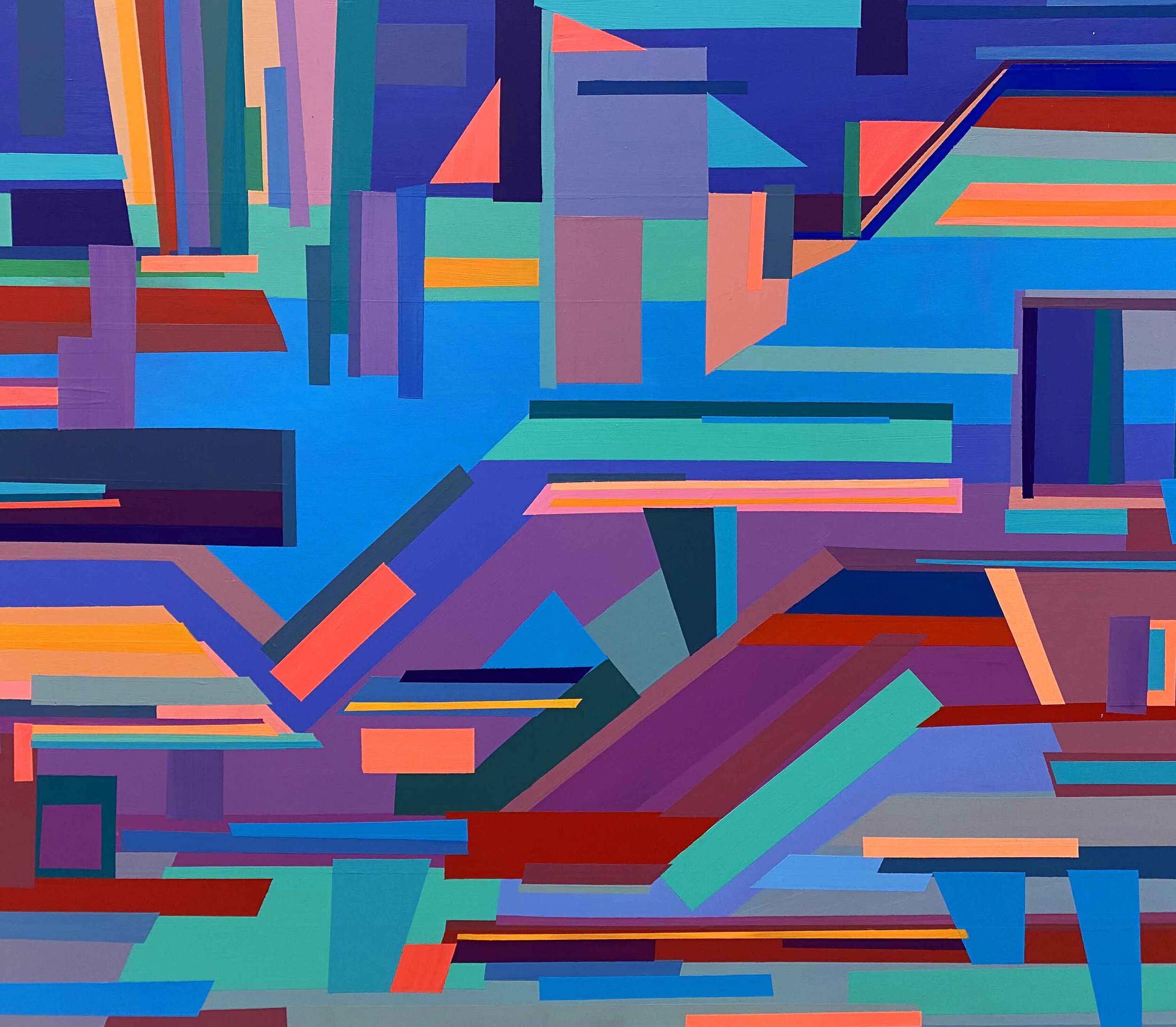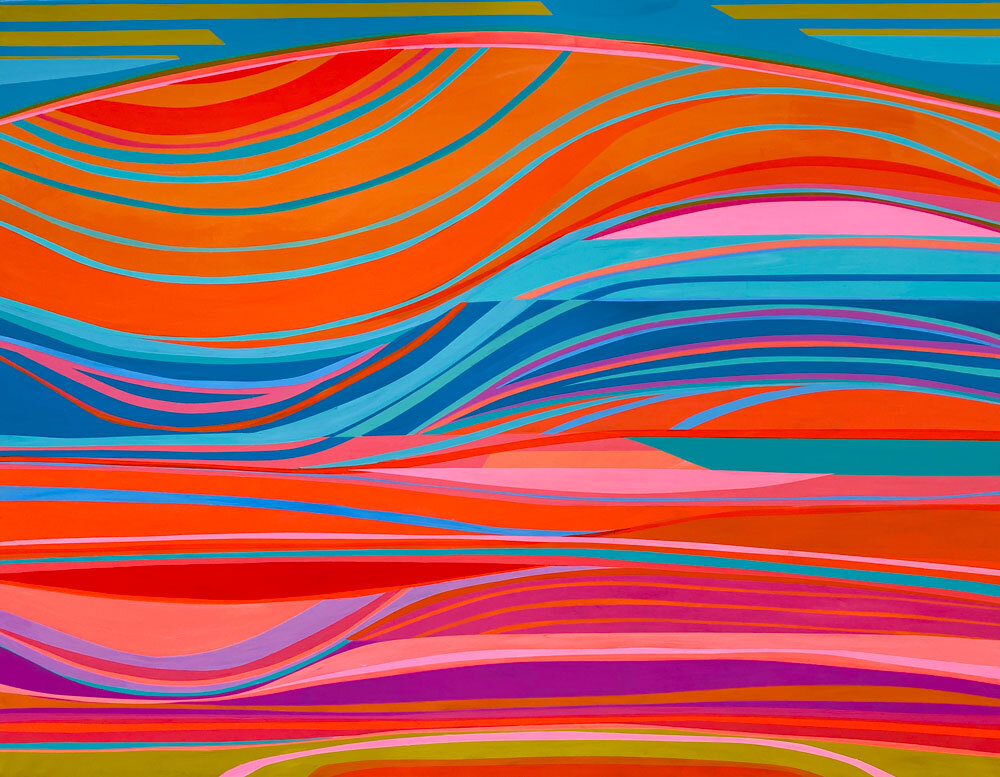Chromatic Affections. Por Carolina Guillermet
18 de septiembre 2020
Texto curatorial de Edgar Cherubini
Carolina Guillermet (1979), artista suizo-costarricense, utiliza el color y la forma para construir un vocabulario abstracto cuyos efectos sugieren una especie de arquitectura emocional, tanto espacial como sensorial, a través de la interacción de patrones y ritmos que extraen diferentes percepciones de luz y volumen y que provocan respuestas sinestésicas mediante sus combinaciones. “Creo en la construcción meditativa de lo visible y, en el planteamiento del color, veo una posibilidad de jugar con afectos que no son coartadas por un exceso de racionalidad”, expresa la artista cuando se propone modificar la percepción de los colores mediante los contrastes, tensiones y vibraciones que interactúan en sus diseños. Los valores cromáticos y estructurales de su abstracción geométrica son los recursos que utiliza para crear el lenguaje autónomo que comunica sus percepciones. En sus obras utiliza diferentes materiales y técnicas para lograr los niveles de saturación, luminosidad y temperatura del color que articulan sus diseños abstractos. En sus acrílicos sobre tela, cuando yuxtapone los colores logra un alto contraste visual. Mientras que, en sus acrílicos y guaches sobre papel, así como en las serigrafías, la fuerza de expresión del contraste del color puro va disminuyendo a medida que emplea colores que se alejan de los tres colores primarios. La saturación, los contrastes y los valores tonales hacen que la vista y las percepciones del observador articulen contradicciones hasta lograr un equilibrio dentro de la abstracción.
Texto curatorial de José Luis Falconi
¿Qué puede esconderse bajo algo tan diáfano como el color? o mejor dicho: ¿hasta qué punto se puede intimar con él, y en él? De alguna manera, ésta ha sido la gran apuesta (o la gran sospecha) desde que la abstracción —ya sea expresiva o geométrica—se postuló como el nuevo horizonte del arte. En el caso de los paisajes abstractos de Carolina Guillermet pareciera que el uso del color, su delicado despliegue en el lienzo busca revelarnos un secreto, una paradoja. Y es que los paisajes de Guillermet son, siempre, paradójicos. Esto es: despliegan siempre una contradicción; en tanto son precisos en su disonancia cromática o compositiva—sus pinturas nacen de una delicada pero rigurosa contraposición de colores, a lo que se les suman desafiantes esquemas arquitectónicos, paisajes casi imposibles, etc. Y es precisamente debido a esa paradoja que se vuelven íntimos—la abstracción de la intimidad se despliega a partir de la continua y discreta disonancia de cada una de sus partes. Si la paradoja de la intimidad se nos figura cercana y a la vez infinita —lo que nos deja entrever, al mismo tiempo, la certera cercanía y la inexorable distancia que tenemos con nosotros mismos—no hay parajes más abstractos que los interiores. Y he aquí, en la obra de Guillermet, una de las más fidedignas versiones de estas, nuestras contradicciones más íntimas.
Curatorial text by Edgar Cherubini
Carolina Guillermet (1979), Swiss-Costa Rican artist, employs color and form to build an abstract vocabulary whose effects suggest a kind of emotional architecture, both spatial and sensory. Through the interaction of patterns and rhythms that extract different perceptions of light and volume she seeks to elicit synesthetic responses through their combinations. "I believe in the meditative construction of the visible and, in the approach to color, I see a possibility of playing with affects that are not restricted by an excess of rationality," explains the artist when she sets out to modify the observer’s perception of colors through contrasts, tensions and vibrations that interact in her designs. The chromatic and structural values of her geometric abstraction are the resources she uses to create the autonomous language that communicates her perceptions. In her work, she uses different materials and techniques to achieve the levels of saturation, luminosity and color temperature that articulate her abstract designs. In her acrylics on canvas, she juxtaposes colors to achieve a high visual contrast. Whereas in her acrylics, gouaches on paper and serigraphs, the force of expression of the contrast of the pure color diminishes as she uses colors that move away from the three primary colors. Saturation, contrasts, and tonal values make the observer's sight and perceptions articulate contradictions until a balance is achieved within the abstraction.
Curatorial text by José Luis Falconi
What can be hidden under something as diaphanous as color? Or rather: to what extent can you be intimate with it, and in it? In a way, this has been the great gamble (or the great suspicion) since abstraction — be it expressive or geometric — was postulated as the new horizon of art. In the case of Carolina Guillermet's abstract landscapes, it seems that the use of color, its delicate display on the canvas, seeks to reveal a secret, a paradox. And it is that the landscapes of Guillermet are, always, paradoxical. That is: they always display a contradiction; while they are precise in their chromatic or compositional dissonance - her paintings are born from a delicate but rigorous contrast of colors, to which are added challenging architectural schemes, almost impossible landscapes, etc. And it is precisely because of this paradox that they become intimate — the abstraction of intimacy unfolds from the continuous and discreet dissonance of each of its parts. If the paradox of intimacy appears close to us and at the same time infinite —which allows us to glimpse, at the same time, the certain closeness and inexorable distance that we have with ourselves — there are no places more abstract than the interiors. And here, in the work of Guillermet, one of the most reliable versions of these, our most intimate contradictions.
La articulación de las contradicciones
Acrílico sobre tela
195 x 145 cm
2019
Acrílico sobre tela
145 x 120 cm
2020
serigrafía
105 x 75 cm papel arches rive 100% algodón 7 tintas tiraje limitado a 28 ejemplares
2019
Acrílico sobre tela
70 x 82 cm
2020
Acrílico sobre tela
180 x 140cm
2020
Acrílico sobre tela
130 x 150cm
2020
Acrílico sobre tela
70 x 90cm
2020
Acrílico sobre tela
145 x 120cm
2020
Acrílico sobre tela
180 x 140cm
2020
Biografía de Carolina Guillermet
Licenciatura en Artes Plásticas, especialidad en Pintura. Escuela de Bellas Artes, Universidad de Costa Rica. Maestría Académica. Arts, Lettres et Langues spécialité Recherche et Création Artistiques. Universidad Toulouse II, Francia. Posgrado en la HEAD (Haute École d’Art et de Design), Ginebra, Suiza. Desde 2003 ha realizado exposiciones individuales en museos y galerías en Costa Rica, Suiza y Francia. Premio Nacional en Pintura en Costa Rica. Ha realizados residencias de especialización en serigrafía y otras técnicas en Suiza, Corea del Sur, China y EE.UU. Fellow curatorial en Queens Museum, 2013. Consultante curatorial en Hammer museum, Los Angeles en 2014, y Research fellow en el Museo de Arte Moderno y Contemporáneo de Seúl, Corea del Sur. Sus propuestas han sido integradas a proyectos de desarrollo urbano y hábitats en Costa Rica, Suiza y Francia.
Biography of Carolina Guillermet
MA Licenciatura en Artes Plásticas, on Painting. School of Fine Arts, University of Costa Rica. Master’s degree in Artistic Research and Creation from the Université Tolouse II, France. Postgraduate at HEAD (Haute École d’Art et de Design), Geneva, Switzerland. She has held solo exhibitions in museums and galleries in Costa Rica, Switzerland and France. Carolina was awarded the National Prize of Painting of Costa Rica in 2006. She has been enrolled in study residences in screen printing and other techniques in South Korea, China and the USA. She was Curatorial Fellow at the Queens Museum in New York in 2013, Curatorial Consultant at the Hammer Museum in Los Angeles in 2015, and Research Fellow at the Museum of Modern and Contemporary Art in Seoul in 2016. She is currently a professor at the School of Fine Arts at the University of Costa Rica.









